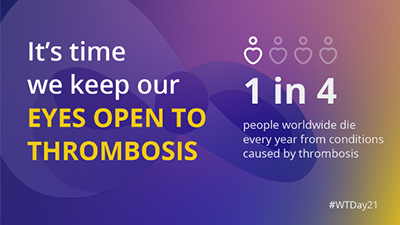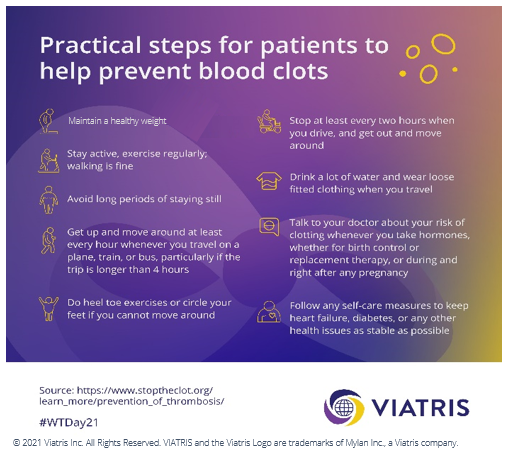Show Menu
Choose Your Location
You are now leaving the Viatris page for a Viatris affiliate site or third party site that is solely responsible for its content, including its compliance with guidelines applicable in certain geographies. Links to Viatris affiliate sites and third party sites are provided as a resource to our visitors and may not be governed by the same regulatory requirements applicable to this site and unaffiliated third party sites are subject to their own terms and data protection notices and practices. Moreover, if their third party site is subject to other country laws, regulatory requirements, data protection requirements or medical practices may differ between countries and the information provided therein may not be suitable for use in your country.

Empowering You
October 13, 2021
One in four people worldwide are dying from conditions caused by thrombosis. Up to 900,000 people in the U.S. alone are affected by blood clots each year; about 100,000 of those people will die, which is greater than the total number of people who lose their lives each year to AIDS, breast cancer, and motor vehicle crashes combined.1 At the same time, research suggests that venous thrombo-embolic events are often preventable, and prevention strategies can help reduce the risk of clot development in people most at risk.2
Viatris is joining the medical community and the World Thrombosis Day campaign3 on its global awareness program that raises awareness of the burden of thrombosis every year on Oct. 13. Encouraging everyone to keep their “Eyes Open to Thrombosis,” this year’s campaign is active in more than 110 countries with nearly 3,000 partners including hospitals, institutions and medical societies.

"At Viatris, we are committed to patients suffering from conditions caused by thrombosis,” said Jean-Phillipe Verbist, regional medical lead for Thrombosis Viatris. “Our goal is to increase awareness of these conditions.”
Hospitalization As a Major Risk Factor
Patients with decreased mobility due to bedrest or recovery, or who experience blood vessel trauma due to surgery or other serious injury, are more likely to develop blood clots. In fact, up to 60% of all venous thrombo-embolism cases occur during or within 90 days of hospitalization, making it a leading preventable cause of hospital death.3
“All physicians should be aware that any hospitalized patient is potentially at risk for blood clots, and it is important that physicians take the necessary time to perform the thrombosis risk assessment, which will drive the appropriate prevention management,” said Dr. Rupert Bauersachs, Scientific Leader of the Action Alliance Thrombosis, Germany.
Dr. Walter Ageno, Director, Emergency Department and Thrombosis Center, Ospedale di Circolo, Varese, Italy, said some patients are especially at risk if they were recently hospitalized with acute medical illness.
“As a daily lifestyle, there are some simple steps to help reduce the risk of clot occurrence – such as better mobility and reducing obesity, or smoking cessation. Taking these simple steps, a person could reduce the risk of developing blood clots,” Dr. Ageno said.